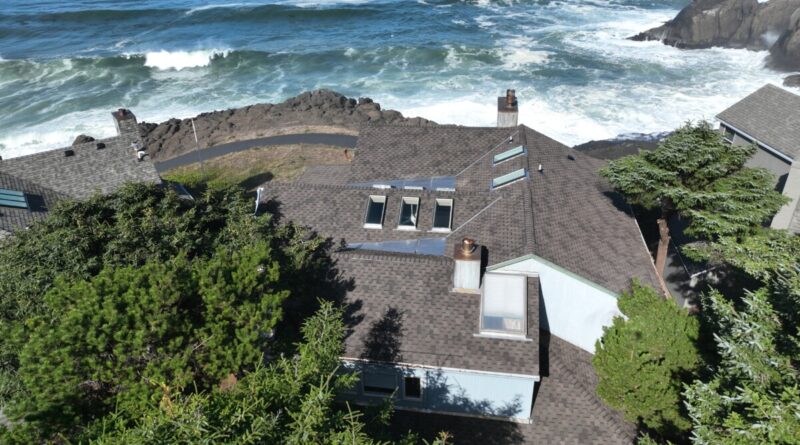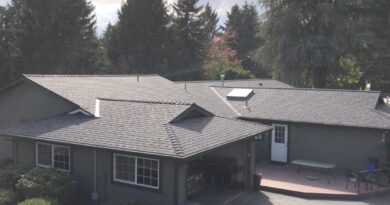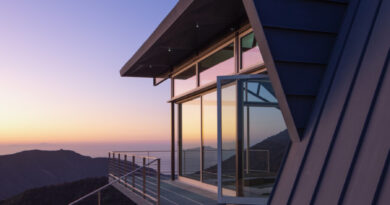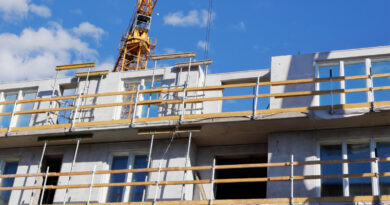Beauty & Resilience
Asphalt Is the Right Choice for Coastal Environments
by Lori Jerome, Marketing Manager, PABCO Roofing Products
Ocean shores are simultaneously breathtaking and abusive. The power and beauty of coastal areas are magnets for human activity and dwellings that allow people to enjoy these unique settings. These salt-air environments are also brutal on the man-made structures that dot our magnificent coasts. The job of roofers in marine areas is a balancing act between cost, value, aesthetics, and longevity. Striking the right balance for residential and commercial roofs in these regions requires both art and science.
Ten Square Roofing, based in Lincoln City, Oregon and owned by Chris Parmenter, deals with the impact of salt-air environments on a daily basis. The company serves customers in the Western region of Oregon’s Central Coast, installing roofs of all types for its customers.
A homeowner in picturesque Depoe Bay, Oregon, a little more than 100 miles southwest of Portland, hired Ten Square Roofing to replace a failing shake roof. Through consultations with the homeowner, asphalt shingles were selected for this 39-square project because of the product’s value, aesthetics, and longevity.
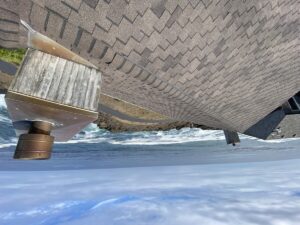
Ten Square Roofing recommended Paramount asphalt shingles in the oakwood color from PABCO® Roofing Products, a top-of-the-line shingle. The contractor had first-hand experience with the level of protection premium Paramount shingles provide to coastal homes.
“My team is exceptionally skilled at designing and installing complicated roofing solutions up and down the Pacific Coast of Oregon,” said Parmenter. “We are not shy about offering our expert opinion and helping our customers understand the roofing design and product options that best protect their homes, garages, cabins, and businesses.”
The contractor overcame multiple challenges throughout the course of the 30-day project. Six tons of old plywood waste with shake still attached was removed from the existing roof and disposed of. 120 sheets of new half-inch plywood were hoisted to the home’s steep, 5/12-pitched, second story roof for installation.
An Equipter was loaded with the new plywood, and each sheet had to be pushed from the first story over the gutter to waiting members of the Ten Square Roofing team, who dragged the sheets over the ridge to stage for use. The built-in pans of the Equipter were used as a makeshift slide for the old plywood sheets, dropping the waste directly into the dump trailer to minimize ground-level mess and labor.
Baffles were built on approximately 75% of the roof, creating a gap between the deck and insulation to prevent moisture build-up and provide adequate airflow. Once the baffles were completed and the roof was sheeted, the contractor installed intake vents to deliver the correct airflow, allowing the house to breathe.
The handcrafting required to properly install this roof was extensive. Ten Square Roofing installed nine all-new, curb-mounted skylights and a new 300lb 74”x54” second-story skylight, with stainless flashing replacing the original aluminum that had been eaten away by salt air.
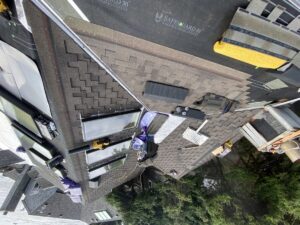
All of the skylight flashing was cut by hand to create an exceptionally reliable system resistant to leaking and rot. 4’x10’ sheets of 26 gauge stainless steel were used for the 1/12 valleys. The metal for the valleys was hand-folded and carefully put in place after all the sheets were locked together. In total, two 5’x20’ sheets were installed for the project.
“The extra attention to detail required by this project is standard practice for us when re-sheeting a vaulted home,” explained Parmenter. “Unlike the typical roof installations in nearby beachfront homes, the roof of this Depoe Bay house is the most advanced in the neighborhood, and it will last longer and perform better.”
The look of the final installation complemented the beachfront surroundings in color and style. Just as important, the new roof was built to withstand harsh marine conditions.
Improved thermal performance within the home’s interior was immediately noticeable. Parmenter monitored the home’s thermostat throughout the project. At the start, the ambient temperature in the house was 74 degrees with no running heat or A/C. Once the roof was complete, the thermostat consistently read 69 degrees, while the outdoor temperature remained nearly identical to the temp at the start of the project. The new roof dropped the ambient temperature within the house by five degrees in the middle of August.
“Chris Parmenter and his team at Ten Square Roofing were incredible,” said homeowner, Ken Zaglin. “Their expertise helped us choose the right roof for our home, and the work they did was beautiful, was better insulated than ever, and built to last.”
